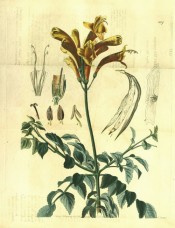Tecomaria capensis (Thunb.) Spach.
Frost tender, erect, scrambling, evergreen shrub with slender stems, 5-7 toothed, slender leaflets per leaf and racemes of slender, tubular, orange to scarlet flowers, up to 7cm long, in summer. To 7m. [RHSE, Hilliers’, Hortus].
Horticultural & Botanical History
‘It is a native of the Cape of Good Hope, whence seeds were sent to Kew by Mr. Bowie in 1823. A hardy greenhouse plant of great beauty. [BR f.1117/1828].
‘It is a climbing plant of free growth, and produces its rich and beautiful flowers in September and October.’ [LBC No. 1672/1830]. Don suggests a date of introduction of 1783 but is probably referring to herbarium specimens.
History at Camden Park
Listed in all published catalogues [T.154/1843]. Well established in the gardens, to the point of being a weed.
Notes
Occasionally naturalised in parts of coastal NSW [FNSW].
Published Feb 27, 2009 - 03:13 PM | Last updated Jul 15, 2010 - 02:01 PM
| Family | Bignoniaceae |
|---|---|
| Category | |
| Region of origin | Southern Africa |
| Synonyms |
|
| Common Name | Cape honeysuckle |
| Name in the Camden Park Record | Bignonia capensis |
| Confidence level | high |
